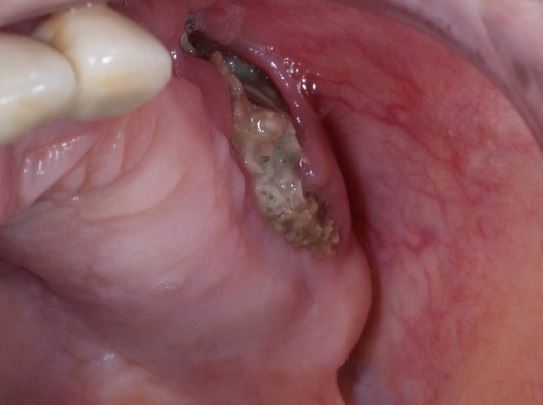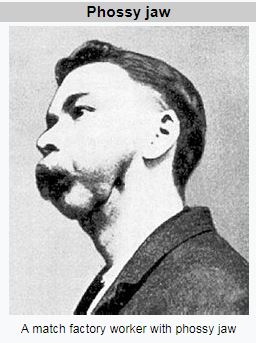A 73 y.o. woman with a hx of breast ca and osteoporosis presents with jaw pain.
hint: she has had two teeth removed but her jaw won't heal.
Our patient had phossy jaw. This is osteonecrosis of the jaw associated with phosphorus poisoning
non healing fistula from dead bone.
. It was first described in people who worked in match factories in the 1800s. Workers dipped treated wood into a white phosphorus solution, dried the sticks and cut them into matches. They worked 12-14 hours a day and the phosphorus was so pervasive in the factories that the walls of the factories had a blue green glow and workers’ clothes glowed in the dark.
Match factory worker with phossy jaw
Today white phosphorus is not used in matches but phossy jaw persists in some patients who are given bisphosphonates for osteroporosis. This was the case in our patient; she developed jaw pain and had teeth removed but the jaw never healed. A sequestrum of dead bone became infected and developed a fistula into the mouth. The same condition can result from bisphosphonates used to treat cancer. 6-11% of patients with multiple myeloma who received bisphosphonate for metastatic bone lesions developed osteonecrosis of the jaw. The percentage is even higher in those with recent dental extractions.
Bisphophonate-related osteronecrosis of the jaw (BRONJ)is thought to be caused by trauma to the teeth that have limited capacity for healing because of the effects of the bisphosphonate therapy. Bisphosphonates bind to osteooclasts and decrease bone turnover. Other non resorptive treatments like denosumab or antiangiogenic treatments can cause jaw necrosis as well.
USELESS TRIVIA
In 1670 phosphorus was discovered by an alchemist who was boiling his own urine in search of gold. After allowing 50 buckets of urine to putrify, Hennig Brandt boiled it and isolated a white waxy substance which glowed in the dark. He named it phosphorus which in Greek means “light bearer”.
Since phosphorus is so flammable, the slightest heat from friction, as in striking a match, can cause it to burst into flame.
Hughes JP, Baron R, Buckland DH, et al. Phosphorus necrosis of the jaw: a present-day study with clinical and biochemical studies. British journal of industrial medicine. 19.83-99.
Hellstein JW, Marek C. Bis-phossy jaw, phossy jaw and the 21st century: Bisphosphate-associated complications of the jaws. Journal of oral and maxillofacial surgery. 62(12):1563-5.
Phosphorus poisoning in the match industry in the United States. JAMA 2010. 303(22)2303.


